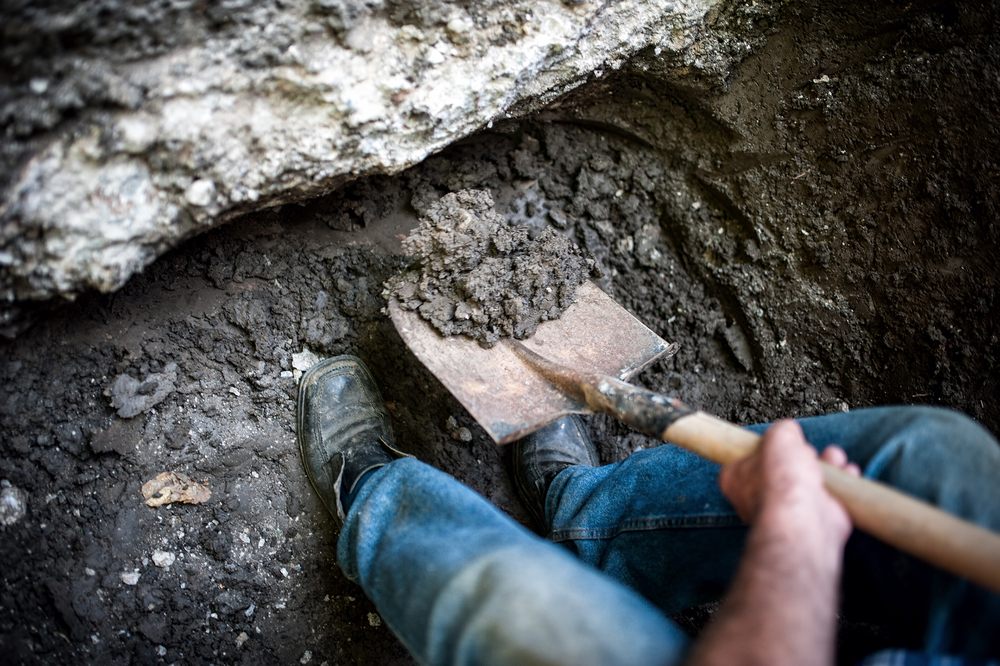The Hole Truth about Why We ‘Dig to China’

Keep digging. (Photo: bogdanhoda/shutterstock.com)
Digging to China is a favorite pastime of American children, not to mention a classic parental joke. Any kid with a shovel in their hand has probably been asked if they were digging to China, told to stop trying to dig to China, or perhaps assigned to the impossible task by an exhausted (or devious) caretaker.
In August of 1937 the New York Times published a cute, two-sentence Associated Press wire story with the headline “Boys Uncover Buried Treasure”. Here is the story in its entirety:
Rochester, N.Y., Six small boys, intent on “digging to China” via Homer Hood’s backyard, struck buried treasure. It was a tiny metal box crammed full of old coins and small denominations, sailor buttons and a gift chain.
How Homer Hood felt about the ditch in his backyard or whether he was entitled to any of the booty has been lost to time. But where exactly did this fanciful notion spring from?

Henry David Thoreau, who wrote about digging to China in Walden. (Photo: Public Domain/WikiCommons)
The first prominent mention of the phrase comes in the middle of the 19th century. In 1854 Henry David Thoreau wrote in Walden, “As for your high towers and monuments, there was a crazy fellow in town who undertook to dig through to China, and he got so far that, as he said, he heard the Chinese pots and kettles rattle; but I think that I shall not go out of my way to admire the hole which he made.”
Less than two decades later, a fictional account of engineers reincarnated as beavers spoke of “the projected tunnel to China that was to be built under the sea and lined with porcelain”, a quite beautiful image if geophysically impossible. By 1899, the notion had made it into religious education. A song called “The Three Little Miners,” chronicling the efforts of a group of children to burrow through a beach to China, even made it into a Sunday school primer: “Three little miners set off one morn / To dig for China land. / Most gravely and bravely off they strode / With shovels and pails for a pick-pack load.”
As television grew in popularity, so too did references to the Big Dig. There are jokes about digging to China in Looney Tunes cartoons, on The Simpsons and in an Eggo Waffle commercial. Sesame Street’s Oscar the Grouch and Telly dig a hole to China in Big Bird in China. (TVTropes.org offers an extensive list of such examples.) In 1987, New York’s National Dance Institute invited 56 school children from China toparticipate in a cross-cultural dance piece. The subject? Digging a hole to China. And as in all things there’s a Kevin Bacon connection—he starred in a 1997 movie with Evan Rachel Wood called Digging to China.

The film Digging to China, starring Kevin Bacon. (Photo: imdb,com)
But despite the cultural pervasiveness of the expression, its exact origins are murky. It’s not commonly chronicled in dictionaries of idioms, euphemisms or slang, although in 1938 a writer recorded an incredibly specific example in an article about auto mechanic lingo published in the journal American Speech. According to this story, in mechanic parlance, “dig-to-china” referred to reboring a cylinder or taking a motor apart. (Also, a “rump bruiser” was a “rough-riding car”.)
What is clear is the the idea of digging to China is rooted in a fundamentally poor understanding of where things are. In geography, an antipode describes the point that is diametrically opposed to another on the globe. And China is not the antipode of the United States. Anyone who wants to undertake a quest to dig from the U.S. to the other side of the earth should bring a raft, because they’ll probably surface in the Indian Ocean. Click anywhere on the United States in this handy online Antipode Map and you’ll receive the message to “Watch out for sharks!” (China’s actual antipodes are Argentina and Chile.) Antipodes are something people have given some thought to over the years, and one man even started a project that encouraged people around the world to make “earth sandwiches” using antipodes—depositing slices of bread on the earth at the same time from corresponding antipodes.

The Antipodes website will tell you what point is diametrically opposed on the globe to your location. (Photo: antipodesmap.com)
There is, of course, another major hurdle standing in the way of digging a hole to China or any other locale: the Earth. If one were to penetrate the thousands of miles of rock that comprise its layers, there remains the issue of surviving its fiery, molten core. Even comparatively modest attempts to simply penetrate the Earth’s crust have failed.
In 1961, a group funded in part by the National Science Foundation undertook Project Mohole, an effort to drill through the Earth’s crust to the “Mohorovičić discontinuity”–the space between the crust and the mantle. (Its cute nickname is “Moho”.) After drilling an unprecedented 601 feet beyond the sea floor off the coast of Guadalupe Island, Mexico, the project was abandoned before Moho was reached.

Project Mohole in action, 1961. Left, the UCSS 1 off Guadalupe Island, Mexico, and right, one of the six submerged buoys used for dynamic positioning. (Photo: Public Domain/WikiCommons)
So where did everyone get the idea that China was on the exact other side of the world from the United States? Geoffrey Nunberg, author and linguistics professor at University of California Berkeley told Atlas Obscura in an email that the idea “had an Orientalist cast” with China and its inhabitants “depicted as the polar opposite of the Westerner in comportment and culture.”
Indeed, the word antipode is also used to describe anything that is the “exact opposite or contrary.”
In spite of faulty geography and Orientalist sentiments, the saying persists, perhaps because it sounds both catchier and more appealing than “Digging a hole to the Indian Ocean.”







Follow us on Twitter to get the latest on the world's hidden wonders.
Like us on Facebook to get the latest on the world's hidden wonders.
Follow us on Twitter Like us on Facebook